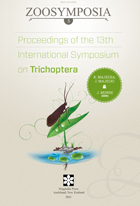Abstract
Despite the sternum V gland being a well known synapomorphy for Trichoptera and Lepidoptera, its ancestral configuration is uncertain. We investigated the sternum V gland in a wide variety of Trichoptera and Lepidoptera to resolve this question. We propose the ground plan to be constituted as follows: The gland is invaginated from sternum V with a slit-like opening and a U-shaped (in cross section) gland duct just inside the opening. Opening muscles originate anteromedially on sternum VI and insert on the walls of the gland duct just inside the opening. The gland reservoir is pressed against the cuticle of sternum IV and in females this area of cuticle is hyaline and perforated. A distinctive arrangement of muscle fibres originates around the perforated cuticle; they insert on the walls of the gland reservoir and facilitate secretion of gland products through the perforated cuticle. Other significant findings were the presence of 2 nonhomologous types of opening muscles in Trichoptera and the scattered distribution of retained ancestral gland features; the latter might imply that these features have been retained as genetic pathways without being physically present in all ancestors of the extant species exhibiting the features.

